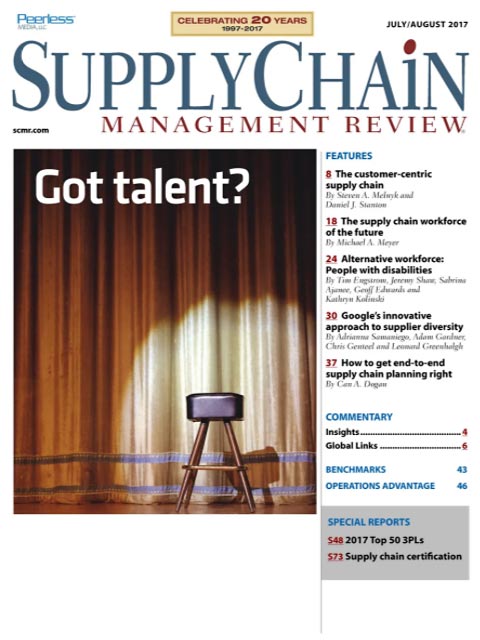Sorry, but your login has failed. Please recheck your login information and resubmit. If your subscription has expired, renew here.
July-August 2017
A few years ago, a Harvard Business Review cover posed the question: What’s the secret to winning in the global economy? The answer: Talent. Browse this issue archive.Need Help? Contact customer service 847-559-7581 More options
The American Midwest is home base for a company that manufactures industrial equipment. Its customers include engineers, designers and maintenance personnel. In the past, the relationship between the customer and the supply chain ran through marketing—the customer talked to marketing and if the information communicated from the customer involved changes to orders, these changes were communicated to supply chain through the sales and operations planning system (S&OP) and the master production schedule (MPS). This relationship was not that unusual: marketing worked with the customer; the planning system coordinated activities; supply chain worked to the schedule. No need for supply chain to talk to—or even know anything about—the customer.
The problem, however, was that this system was not working. It took too long for changes and requests to work their way to the supply chain. Even when they were communicated, the changes were often distorted as marketing added their “spin” to the information. Even worse, the supply chain and the customer were not even aligned. The supply chain focused on cost and meeting the schedule; the customer often wanted responsiveness and flexibility. Ultimately, customers became frustrated; supply chain personnel became confused (if we met the plan then why was the customer upset); and top management was concerned with competitive pressure increasing and long-term customers buying from the competition. In response to these developments, top management formulated a radical solution: Cut out the middleman. Instead of the conversation beginning with marketing, supply chain would get to know the customers up close and in person; supply chain would focus on those things that customers wanted (and would be willing to pay for).
The new system delivered unexpected results. Customers now began to see the firm in a far more positive light relative to the competition. In addition to strengthening their brand, they discovered that customer complaints dropped, lead times fell and performance improved. For the first time, the supply chain team was able to align its goals with their customers’ needs because they understood whom they were serving from first-hand experience. When there was a problem, the supply chain team had a new perspective on the issues, and could think more creatively about how best to resolve them. Unlike in the past, cost was no longer the primary driver. Ultimately, the company had discovered the power of the customer-centric supply chain.

This complete article is available to subscribers only.
Log in now for full access or start your PLUS+ subscription for instant access.
SC
MR
Sorry, but your login has failed. Please recheck your login information and resubmit. If your subscription has expired, renew here.
July-August 2017
A few years ago, a Harvard Business Review cover posed the question: What’s the secret to winning in the global economy? The answer: Talent. Browse this issue archive. Access your online digital edition. Download a PDF file of the July-August 2017 issue.The American Midwest is home base for a company that manufactures industrial equipment. Its customers include engineers, designers and maintenance personnel. In the past, the relationship between the customer and the supply chain ran through marketing—the customer talked to marketing and if the information communicated from the customer involved changes to orders, these changes were communicated to supply chain through the sales and operations planning system (S&OP) and the master production schedule (MPS). This relationship was not that unusual: marketing worked with the customer; the planning system coordinated activities; supply chain worked to the schedule. No need for supply chain to talk to—or even know anything about—the customer.
The problem, however, was that this system was not working. It took too long for changes and requests to work their way to the supply chain. Even when they were communicated, the changes were often distorted as marketing added their “spin” to the information. Even worse, the supply chain and the customer were not even aligned. The supply chain focused on cost and meeting the schedule; the customer often wanted responsiveness and flexibility. Ultimately, customers became frustrated; supply chain personnel became confused (if we met the plan then why was the customer upset); and top management was concerned with competitive pressure increasing and long-term customers buying from the competition. In response to these developments, top management formulated a radical solution: Cut out the middleman. Instead of the conversation beginning with marketing, supply chain would get to know the customers up close and in person; supply chain would focus on those things that customers wanted (and would be willing to pay for).
The new system delivered unexpected results. Customers now began to see the firm in a far more positive light relative to the competition. In addition to strengthening their brand, they discovered that customer complaints dropped, lead times fell and performance improved. For the first time, the supply chain team was able to align its goals with their customers' needs because they understood whom they were serving from first-hand experience. When there was a problem, the supply chain team had a new perspective on the issues, and could think more creatively about how best to resolve them. Unlike in the past, cost was no longer the primary driver. Ultimately, the company had discovered the power of the customer-centric supply chain
 SUBSCRIBERS: Click here to download PDF of the full article.
SUBSCRIBERS: Click here to download PDF of the full article.
SC
MR


Latest Supply Chain News
- How CPG brands can deliver on supplier diversity promises
- How S&OP provides the answer to in-demand products
- AI, virtual reality is bringing experiential learning into the modern age
- Humanoid robots’ place in an intralogistics smart robot strategy
- Tips for CIOs to overcome technology talent acquisition troubles
- More News
Latest Podcast

 Explore
Explore
Business Management News
- How CPG brands can deliver on supplier diversity promises
- How S&OP provides the answer to in-demand products
- AI, virtual reality is bringing experiential learning into the modern age
- Tips for CIOs to overcome technology talent acquisition troubles
- There is still work to do to achieve supply chain stability
- Blooming success: The vital role of S&OE in nurturing global supply chains
- More Business Management
Latest Business Management Resources

Subscribe

Supply Chain Management Review delivers the best industry content.

Editors’ Picks





